Lines and other markings painted on the pavement are also used to control and direct traffic. Sometimes these lines will include reflective raised pavement markers, which make the lines more visible. Markers may also be used to simulate the lines.
 Yellow and white are the two most common colors of pavement markings. Lines in these two colors have different meanings. You should be able to determine where you are on a roadway by the color and type of the lines.
Yellow and white are the two most common colors of pavement markings. Lines in these two colors have different meanings. You should be able to determine where you are on a roadway by the color and type of the lines.
YELLOW Centerline Markings
Yellow lines parallel to the roadway mark the center of a roadway on which there is two-way traffic. Yellow lines are used in different configurations that have different meanings.
- If there is a single solid yellow line dividing lanes of traffic, you may not drive over this line to pass other vehicles.
- You may cross over a solid yellow line to make a left turn at an intersection, to enter or exit a road or a driveway or to make a U-turn, if it can be made safely and is not otherwise prohibited.
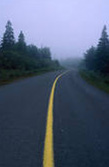 On divided highways and some other roadways, a single solid yellow line will usually be used to indicate the left most boundary of the drivable roadway. You should not drive to the left of this line. Sets of solid yellow lines are frequently used to divide oncoming lanes of traffic before an upcoming hazard such as a road obstruction caused by the pillar of an over-crossing.
On divided highways and some other roadways, a single solid yellow line will usually be used to indicate the left most boundary of the drivable roadway. You should not drive to the left of this line. Sets of solid yellow lines are frequently used to divide oncoming lanes of traffic before an upcoming hazard such as a road obstruction caused by the pillar of an over-crossing.
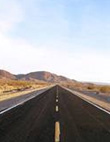 If there is a single yellow line dividing lanes of traffic and the line is broken, you may pass over this to pass other vehicles and to make left turns into other streets, driveways and alleys, if it can be done safely.
If there is a single yellow line dividing lanes of traffic and the line is broken, you may pass over this to pass other vehicles and to make left turns into other streets, driveways and alleys, if it can be done safely.
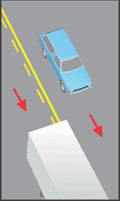 If there are two yellow lines dividing lanes of traffic and the line closest to your lane is broken, you may cross over it to pass vehicles ahead, if it is safe to do so. If the line closest to your lane is solid, you may not cross over it except to turn left into a driveway or alley.
If there are two yellow lines dividing lanes of traffic and the line closest to your lane is broken, you may cross over it to pass vehicles ahead, if it is safe to do so. If the line closest to your lane is solid, you may not cross over it except to turn left into a driveway or alley.
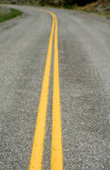 If there are two solid yellow lines dividing lanes of traffic, you may not cross over them to pass another vehicle. You should never drive to the left of these lines. You may cross over a double solid yellow line to make a left turn at an intersection, to enter or exit a road or a driveway or to make a U-turn, if it can be made safely and is not otherwise prohibited.
If there are two solid yellow lines dividing lanes of traffic, you may not cross over them to pass another vehicle. You should never drive to the left of these lines. You may cross over a double solid yellow line to make a left turn at an intersection, to enter or exit a road or a driveway or to make a U-turn, if it can be made safely and is not otherwise prohibited.
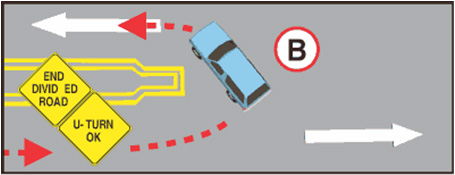 Two sets of solid double yellow lines that are two or more feet apart represent a wall or center divider. You may not drive on or over these lines for any reason. You may only make a U turn or left turn on a street divided with these lines at an opening provided for turns.
Two sets of solid double yellow lines that are two or more feet apart represent a wall or center divider. You may not drive on or over these lines for any reason. You may only make a U turn or left turn on a street divided with these lines at an opening provided for turns.
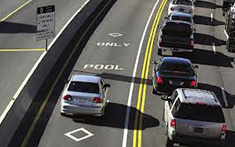 In some cases, one or more sets of parallel solid yellow lines are also used to separate carpool lanes from normal traffic lanes. Do not cross over these lines to enter or exit the carpool lane. Wait until the lines are broken or for some other designated place to enter or exit the lane.
In some cases, one or more sets of parallel solid yellow lines are also used to separate carpool lanes from normal traffic lanes. Do not cross over these lines to enter or exit the carpool lane. Wait until the lines are broken or for some other designated place to enter or exit the lane.
A center traffic lane enclosed by double yellow lines on each side with the inner lines broken may be used to start and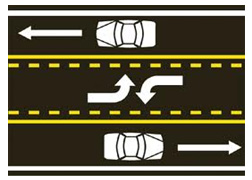 complete left hand turns and start U-turns from either direction of traffic but cannot be used for passing.
complete left hand turns and start U-turns from either direction of traffic but cannot be used for passing.
Rules for Proper Use of Center Left Turn Lanes
- You must use the center left turn lane to make a left turn or U turn if one exists on the street you are driving. You must signal and completely enter the lane before making your left- hand turn. Don’t stop part way into the lane with your vehicle blocking traffic.
- You may only drive in this lane for a distance up to 200 feet, which is about the length of five or six vehicles. The limit on driving in a center left turn lane is to help prevent drivers from using this lane as a regular traffic lane or as a passing lane. You may not use a center left-turn lane for either of these purposes.
- Be cautious and look for vehicles coming from the opposite direction that are pulling into a center left turn lane. Because of the potential for meeting other vehicles coming from opposite direction head-on, center left turn lanes are often referred to as “suicide lanes.”
- When turning left from a side street or driveway, you have the option to use this lane before completing your turn. If you want to first turn into the center left-turn lane, you should signal, wait until it is safe and then drive completely into the center left turn lane. Wait in the lane with your right- turn signal on for traffic to clear before pulling into traffic. Alternatively, if traffic is clear in both directions, you can make your left turn directly from the side street or driveway, without first stopping in the center left turn lane.
- Turn signal on for traffic to clear before pulling into traffic. Alternatively, if traffic is clear in both directions, you can make your left turn directly from the side street or driveway, without first stopping in the center left turn lane.
 Broad yellow lines crossing the road are sometimes painted near school crossings. Sometime the words “SCHOOL XING”
Broad yellow lines crossing the road are sometimes painted near school crossings. Sometime the words “SCHOOL XING” 
 are used. You should carefully scan for children about to cross or crossing the road when you see these markings.
are used. You should carefully scan for children about to cross or crossing the road when you see these markings.
WHITE Centerline Markings
White lines of different configurations indicate different meanings.
- White lines parallel to the roadway separate lanes of traffic going in the same direction, including bicycle lanes from car lanes.
- Messages such as “STOP AHEAD” or arrows directing traffic in a particular lane are often painted on the pavement in white.
- White lines, which cross the roadway, delineate crosswalks or limit lines.
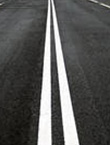 A single or double solid white line dividing traffic lanes going in the same direction cannot be crossed for any reason.
A single or double solid white line dividing traffic lanes going in the same direction cannot be crossed for any reason.
- On divided highways, a single solid white line will usually be used to indicate the rightmost boundary of the drivable roadway.
- You should not drive to the right of this line.Sets of solid white lines are frequently used to divide the lanes before an upcoming hazard such as a road obstruction caused by the pillar of an over-crossing, or the median between a freeway off-ramp and normal traffic lanes.
- These lines should not be crossed.
- Thicker solid white lines are used to separate parts of left and right turn lanes close to the intersection.
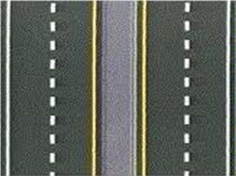
- If a single broken white line divides lanes of traffic, you may cross over the line to enter the lane next to you.
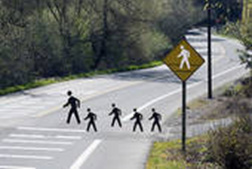 Crosswalks are delineated with sets of broad white lines, which cross the road. Crosswalks are often preceded by white words painted on the road indicating “SLOW PED XING.” There are special rules that the driver must follow when dealing with pedestrians crossing the roadway, but in general you should always stop behind the crosswalk when you must stop at an intersection.
Crosswalks are delineated with sets of broad white lines, which cross the road. Crosswalks are often preceded by white words painted on the road indicating “SLOW PED XING.” There are special rules that the driver must follow when dealing with pedestrians crossing the roadway, but in general you should always stop behind the crosswalk when you must stop at an intersection.
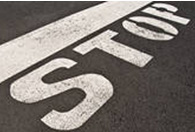 Thick solid white lines that cross the roadway are used to mark the limit line at intersections and the clearance line at RR crossings. You must stop behind these lines at an intersection or railroad crossing. White painted letters on the pavement such as “RXR” often precedes the limit lines at railroad crossings.
Thick solid white lines that cross the roadway are used to mark the limit line at intersections and the clearance line at RR crossings. You must stop behind these lines at an intersection or railroad crossing. White painted letters on the pavement such as “RXR” often precedes the limit lines at railroad crossings.
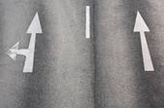 White arrows are sometimes painted on the roadway to indicate whether the lane proceeds ahead, merges, turns or exits. These arrows are intended to guide your choice of lane.
White arrows are sometimes painted on the roadway to indicate whether the lane proceeds ahead, merges, turns or exits. These arrows are intended to guide your choice of lane.

 Large white letters and symbols are often painted on the road to warn you of upcoming signals, stop signs, changes in the lane, bicycle lanes and crosswalks. You should keep an eye on the roadway surface for these messages when you are driving.
Large white letters and symbols are often painted on the road to warn you of upcoming signals, stop signs, changes in the lane, bicycle lanes and crosswalks. You should keep an eye on the roadway surface for these messages when you are driving.
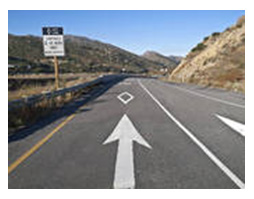 Diamonds painted in a lane indicate that lane is for the use of buses and carpools only. Using a carpool lane requires a minimum of 2 or 3 people in your vehicle.
Diamonds painted in a lane indicate that lane is for the use of buses and carpools only. Using a carpool lane requires a minimum of 2 or 3 people in your vehicle.

